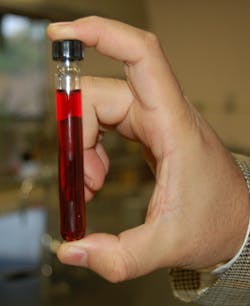Dye-sensitized solar cells could get a boost from NCSU-10, a new dye
Raleigh, NC--A dye created by a research group at North Carolina State University may improve the efficiency of dye-sensitized solar cells (DSSCs).
DSSCs are made of inexpensive and environmentally benign materials that include a dye, an electrolyte, and titanium dioxide (TiO2). DSSCs absorb photons from incident light to create free electrons in nanoporous semiconductors, such as TiO2, in the cell, generating an electric current. Owing to their independence on the angle of incident light and high response to low level of lighting conditions, DSSCs outperform conventional silicon photovoltaics by 20% to 40% under diffuse light, on cloudy and/or rainy days, and in indoor ambient light.
Ahmed El-Shafei’s research group invented a new dye sensitizer that harvests more ambient and solar light than any dyes currently on the market for use in DSSCs. “A third-party solar energy company compared our new dye, NCSU-10, against the state-of-the-art dye on the market,” says El-Shafei, an assistant professor in the Textile Engineering, Chemistry and Science department. "Our dye had 14% more power density. In other words, NCSU-10 allows us to harvest more energy from the same amount of light.”
A patent is pending on the new dye, and the university is in communication with potential industry partners about licensing use of NCSU-10, as well as funding additional research in this area.

John Wallace | Senior Technical Editor (1998-2022)
John Wallace was with Laser Focus World for nearly 25 years, retiring in late June 2022. He obtained a bachelor's degree in mechanical engineering and physics at Rutgers University and a master's in optical engineering at the University of Rochester. Before becoming an editor, John worked as an engineer at RCA, Exxon, Eastman Kodak, and GCA Corporation.
